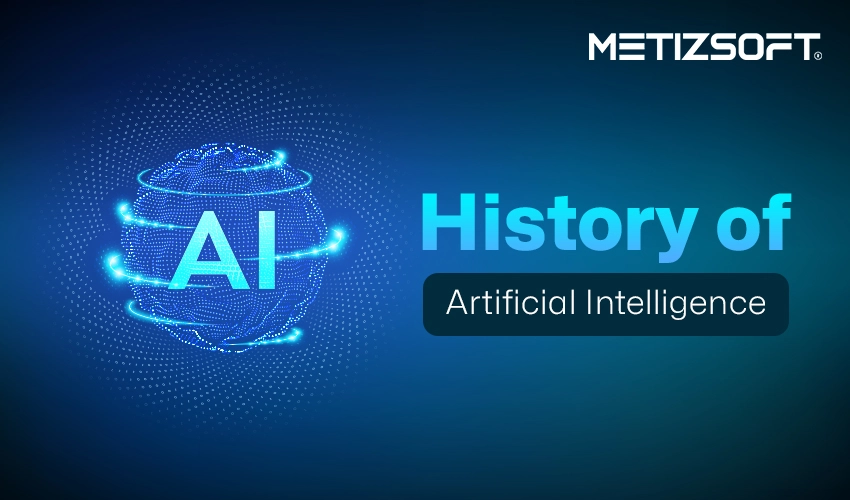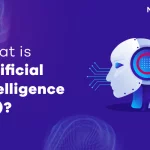
Throughout the centuries leading up to the 1950s, numerous philosophical and logical concepts emerged, laying the groundwork for artificial intelligence (AI) theories. Over time, these concepts evolved to focus more on the potential for machines to learn and on integrating artificial intelligence technology into human life.
The history of AI is a continuous dialogue between theory and practice. Theoretical advancements have fuelled practical applications, which have driven further theoretical development. The field of AI is vast and multifaceted, encompassing various subfields like machine learning (ML), natural language processing (NLP), and computer vision.
Let’s dig deeper into the history of AI and find out the roots behind the supreme tech currently running the world in this blog post.
Table of Contents
Understanding Artificial Intelligence (AI)
You will find countless AI definitions on the internet and in books. Everyone has their own way of expressing what AI is. In my post-graduation days, a brilliant mind came up with a definition: “Machines that act like humans and make things easy for us are Artificial Intelligence.“ He came up with a coffee machine example, referring to his statement. From that day to now, I haven’t come across a better explanation of AI.
Anyway, readers always seek more information and clarification. So here’s a simplified definition of AI for you:
Artificial intelligence, commonly known as AI, refers to computer systems that mimic human thinking and capabilities, including learning. Contrary to what is often depicted in movies, the goal is not to create robots that will take over the world but to build machines that can seamlessly perform tasks that require human intelligence.
For example, The voice assistant on your phone – These programs can understand your voice commands and respond accordingly. They use AI to interpret what you’re saying and then take action, such as setting an alarm, playing music, or making a call. It’s like having a super helpful friend who’s always there to listen and assist you.
The primary job of AI is to teach computers to learn and adapt, improving at specific tasks as they perform them more frequently. It’s a powerful tool that revolutionizes the world in various ways, aiding our daily tasks and leading to new scientific discoveries!
The Founders: Minds Behind AI!
During World War II, Alan Turing developed the code-breaking machine, The Bombe, to decode the German Enigma code. In 1950, he also proposed the “Computer Machinery and Intelligence,” a test of machine intelligence called The Imitation Game.
It was renowned as the Turing Test and became a benchmark for evaluating the intelligence of artificial systems. According to this test, if a human cannot distinguish between interacting with another human and a machine, then the machine is considered intelligent.
The word/term Artificial Intelligence was then officially coined about six years after 1950.
In 1956, Marvin Minsky and John McCarthy organized the Dartmouth Summer Research Project on AI at Dartmouth College. This workshop, funded by the Rockefeller Foundation, marked the beginning of the AI Spring and brought together future AI founders.
Artificial Intelligence (AI) Timeline
The timeline of artificial intelligence traces back to 1763 when Thomas Bayes pioneered a framework for the probability of events known as the Bayesian reference, which has since become a foundational approach for machine learning.
- 1943: Warren McCulloch and Walter Pits proposed a model of artificial neurons 1943, marking the beginning of what is now recognized as AI.
- 1949: Donald Hebb showed how neurons’ connection strength can be adjusted, now known as Hebbian learning.
- 1950: In 1950, English mathematician Alan Turing published “Computing Machinery and Intelligence,” which proposed the Turing test. This test checks a machine’s ability to exhibit intelligent behavior equivalent to human intelligence.
- 1955: Herbert A. Simon and Allen Newell developed the first artificial intelligence program, “Logic Theorist,” which proved 38 of 52 mathematical theorems and found more elegant proofs for some theorems.
- 1956: American computer scientist John McCarthy coined “Artificial Intelligence” at the Dartmouth Conference.
- 1960s: The first industrial robot started working at a General Motors factory, and the program ELIZA was developed to enable English conversations with a person.
- 1970s: The first anthropomorphic robot with basic abilities was built in Japan, and Stanford University developed an early bacteria identification system.
- 1980s: Mercedes-Benz tested the first driverless car, embodying the foundational principles of modern cars. Jabberwocky is released as an early example of a modern chatbot system.
- 1990s: Deep Blue, a chess-playing computer, defeats the reigning world champion. Google’s first web index includes 26 million pages.
- 1997: In 1997, IBM’s Deep Blue defeated world chess champion Gary Kasparov, marking the first time a computer had beaten a world chess champion.
- 2000s: New robots like Honda’s ASIMO and MIT’s Kismet have been developed. The volume of digital information is increasing in the hundreds of exabytes. Google’s web index has reached 1 billion pages in just two years.
- 2002: For the first time, AI entered the home as a vacuum cleaner, Roomba.
- 2006: AI entered the business world in 2006. Companies like Facebook, Twitter, and Netflix began using AI.
- 2010: IBM’s Watson computer beat two former “Jeopardy!” champions. The global internet user count exceeded 4 billion.
- 2011: In 2011, IBM’s Watson won Jeopardy by quickly solving complex questions using natural language understanding.
- 2012: Google launched an Android app feature called “Google Now,” which provided information to the user as a prediction.
- 2014: The chatbot “Eugene Goostman” won the renowned “Turing test” competition.
- 2018: The IBM “Project Debater” debated complex topics with two master debaters and performed exceptionally well.
- 2019: Google’s AlphaStar achieved Grandmaster rank in the video game StarCraft 2, surpassing all but 0.2% of human players.
- 2020: OpenAI beta tests GPT-3, an advanced model that uses a Deep Learning module to create code, poetry, and other writing tasks. It produces content almost indistinguishable from human-created content.
- 2021: OpenAI created DALL-E, which can process images to generate accurate captions, advancing AI’s understanding of the visual world.
The Future of AI: A Story Yet to be Written!
The history of artificial intelligence (AI) is a testament to human creativity and our never-ending pursuit of creating intelligent machines. As we progress, AI holds immense potential to address complex everyday challenges and improve our lives in countless ways.
Whether it’s in the IT sector, healthcare, finance, banking, telecom, or the automobile industry, the future of AI promises to be more robust, creating opportunities for greater freedom for people in different fields.
AI is in the early stages of development, and the human mind has yet to fully discover its capabilities or have a glimpse of them. But, the outcome so far says that AI has developed remarkably, with concepts such as deep learning, big data, and data science now trending.
Tech giants like Google, Facebook, IBM, and Amazon work with AI to create excellent devices. Meanwhile, mid-firms like Metizsoft Solutions have liberated AI development services to bring impeccable solutions to their worldwide clientele. The future of Artificial Intelligence is inspiring, although there are concerns about potential job reductions due to automation. Nonetheless, AI is expected to bring about high intelligence.
AboutChetan Sheladiya
Related Posts
Build AI-Powered App Using OpenAI API Guide: Benefits, Steps, Cost & More
Table of Contents IntroductionBenefits of Using OpenAI API for Your BusinessSteps Involved in Building AI App Using OpenAI...
The Role of Artificial Intelligence (AI) in the ECommerce Industry
Table of Contents IntroductionUse Cases AI in ECommerceAI-driven Future for ECommerceLeverage AI-driven Solutions for...




